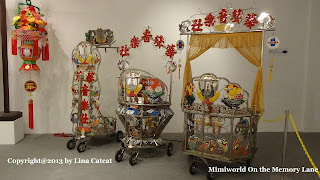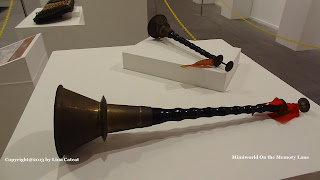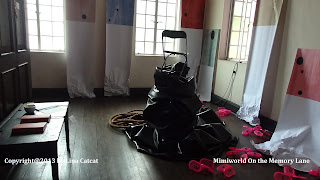Teochew Building - Ngee Ann Kongsi
It was on hot afternoon Saturday, when my hubby and I went to the most traditional Teochew Music and Opera 2013 located at 97 Tank road. Teochew Music is the most popular form of folk instrumental musicology in the Teochew regions of Guangdong Province, China. The origins of Teochew music can be traced to the reign of the Tang (618-907) and Song dynasties (960-1279) while Teochew Opera is a genre of Chinese opera performed in the Teochew dialect with over 450 years of history. Most popularly among the Teochew speaking population in the Chaoshan province, it travelled with their ancestors as they migrated to countries all around the world.I was told by my mum many years ago that she was formerly worked as singer opera that sung a Teochew and Hokkien song when she was in her teens years before she set up her own salon shop in Johor, Malaysia. She was a long time supporter of opera since. Most of her opera friends had passed on. I had bought Opera VCD for her to watch years ago and sometimes she watched Chinese Opera on TV when there is a show. And yet she talks to me in Teochew!
Short brief history of Seah Eu Chin (1805-1883): Founder of Ngee Ann Kongsi, Seah Eu Chin, who had two wives Tan Beng Guat and Tan Beng Choo. Seah Eu Chin passed away in 1883 and buried at Bukit Brown Cemetery. About the year in 1845, the late Seah Eu Chin, at that time a prominent Teochew merchant in Singapore and 12 other Teochew merchants then in Singapore, promoted the formation of a fund for the propagation and observance in Singapore of the doctrines, ceremonies, rites and customs of the Chinese religions as observed by the Teochew community. Here is the blog about Seah Eu Chin
Flyer
They opened their ceremony and their performance on Fri 14 June 2013 with other programmes and thus two programmes on 15th & t6th June 2013 Teochew Gongfu Tea Ceremony (2pm and 5pm) and Traditional Chinese Music presentation (3pm to 4.30pm) where visitors will be treated to their tea and listened to their music performance. Unfortunately, we missed it for two programmes and we managed to snap photos of their traditional instruments as well as art paintings on the wall that beautifully painted designed of all regions.
Teochew Building's entrance doors
Teochew Building's interior doors has three Chinese wordings inscribed on each door comprises three renowned clan associations - Ngee Ann Kongsi (义安公司), Teochew Poit Ip Huay Kuan (潮州八邑会馆) and others. Recently in April 2013, the founder of Breadtalk, George Quek age 57 became a new leader of the umbrella body for Teochew clans in Singapore on Monday 1st April 2013 and vowed to unite the community, took over the helm at the 84-year-old Teochew Poit Ip Huay Kuan, one year after some leaders of the Teochew philanthropic foundation Ngee Ann Kongsi launched a rival Teochew Federation in their personal capacities.
Ngee Ann Exhibition Hall & Auditorium
At least we are glad to be able to see those old traditional instruments of all old times and it displays at exhibitions music hall widely seen clearly on each side by side. Their supportive of festivals from the associations namely; Er Woo Armateur Musical & Dramatic Ass'n, Thau Yong Armateur Musical Ass'n, Nam Hwa Armateur Musical & Dramatic Ass'n, Hwa Siah Musical Ass'n and the Teochew Drama Ass'n for their music performance. And also one of their corporate business, Eng Tiah Huat for exhibiting Chinese musical instruments during 1-week exhibition till 20 June 2013.
Teochew Gongfu Tea ceremony
There was a Teochew Gongfu Tea ceremony which visitors looked forward to how the tea is served in traditional way. There was a master of tea ceremony giving a live demonstration of making tea and brewing art.
Close-up of Traditional Tea set
I had a set of traditional tea of my own that I keep more than 2 decades which is different from exhibits and it is of flowers design comes with red retro-design box and you may look here.
Traditional Tea demonstration
Beside this, visitors will be treated to the music performance after the tea taste.
Live Musical Performance
There was also a live musical performance at the hall while visitors sat for soothing listen to the music bands from various clan associations. The melodies of the Teochew music are clear and quaint, exuding the classic charm of ancient Chinese music as what I had seen it before long time ago.
Exhibits from Musical Associations
These three exhibits displayed from Musical Associations that they performed a live stage at the hall on 1st first opening ceremony 14th Jun 2013.
Sanxian (left) & Modern Pipa (right) - Four-stringed lute
Pipa (pronounced "pee-paa") is a four-stringed lute, one of the oldest Chinese musical instruments with over 2000 years of history.
Sanxian (a long-necked lute) is a 3-string plucked instrument with snake skin membrane stretched over a resonator. Owing to its distinctive acoustical properties - rich, full tonal quality, great volume and a wide range - the Sanxian is widely used for accompaniment, orchestral and solo performances. Variation in the art of playing the sanxian also enables the long neck to be adapted for different uses. Sanxian is made in 3 sizes: large, medium and small. The large one is used mainly for accompanying story singing and music drama performances.
The name Banhu comes from the wooden soundboard covering the half globular resonating chamber. Of its many other names the most prominent may be Banghu, referring to its historical use in the northern Bangzi opera in the mid 17th century. Then it came to accompany many other regional operas and popular narratives, spreading over northern China.
The two strings are generally tuned a fifth, or a fourth apart. Strident and bright in tone quality the Banhu is used as a solo instrument and as a group within the bowed strings in the modern Chinese orchestra.
YangQin Chinese Instrument
YangQin (Chinese Dulcimer) comes in a variety of sizes. The YangQin is a dulcimer played with bamboo mallets, with the size of a chopstick, and one held in each hand, are used to hit strings in pairs. This produces a high and tinkling timbre in its top registers, a soft and beautiful tone in the middle and a strong rich sound in the lower registers. The metallic tone resembles the harpsichord. It has the widest range of scale amongst the Chinese plucked-strings instruments (about 5 octaves).
Zheng (Plucked String Instrument)
Chaozhou Zheng (Plucked String Instrument)
Zheng is an ancient Chinese instrument. It has been developed from a small instrument made from bamboo, originally used by herdsman. It was very popular during ancient times, as early as the Warring States Period and the Qin Dynasty (225 to 206 BC and earlier). The Zheng has an arched surface and is elongated-trapezoidal with 13 to 21 strings stretched over individual bridges. Although metal strings are common today, the strings were of silk in ancient times. The Zheng rests on two pedestals and is played using 3 to 4 imitation fingernails. On the right side of the bridges, both hands pluck the strings and on the left side, the left fingers bend the strings to change pitch or to provide embellishment. Its playing range spans three to four octaves. We had this instrument made when we worked in Chengdu at the music conservatory.
This Chaozhou Zheng is a short distance, effective string with large cross-sectional curvature panel emoting a resonance sound of much intensity. The right hand is used to strike the chord and left hand will employ techniques such as rubbing and pressing. Sharp sound effect to bring out the unique style and charm of Teochew Music.
This Chaozhou Zheng is a short distance, effective string with large cross-sectional curvature panel emoting a resonance sound of much intensity. The right hand is used to strike the chord and left hand will employ techniques such as rubbing and pressing. Sharp sound effect to bring out the unique style and charm of Teochew Music.
Zhonghu, Banhu, Gaohu & Dahu
This instrument is a variety of the Huqin and because it uses a wooden sounding board in the sound box. Also known as Bonghu (clapper huqin) because it was heard in the Bangzi or "clapper operas" of the 17th century. It appears during the Qing Dynasty.The name Banhu comes from the wooden soundboard covering the half globular resonating chamber. Of its many other names the most prominent may be Banghu, referring to its historical use in the northern Bangzi opera in the mid 17th century. Then it came to accompany many other regional operas and popular narratives, spreading over northern China.
The two strings are generally tuned a fifth, or a fourth apart. Strident and bright in tone quality the Banhu is used as a solo instrument and as a group within the bowed strings in the modern Chinese orchestra.
Zhonghu Fig. 1 (two string viola) This middle hu is an alto erhu of large dimensions in the neck and resonator, developed in the 1940s in an attempt to build Chinese instruments in families As in their constructions the two types are similar in performing techniques. Only the alto's strings are tuned a fourth or fifth lower than those of the erhu. As an alto instrument with a two-octave range, the type has a deep and gloomy tone. The zhonghu is commonly used in ensembles and accompaniments, and for solos as well. The zhonghu is tuned as A, E or G, D.
Devil mask is a whole face, green colour mask, often coupled with ruffled hair wigs. It is usually worn to portray ghost and devil roles.
These 2 masks are one of the main masks in Teochew opera for disguising as specific characters or to depict the inner world of a certain role. But in present, it is not commonly used any more.
Furthermore, there are many Chinese cultures items on displays and if that is interested to you. You may visit to Teochew Building located at 97 Tank Road. Their exhibitions started from 14th Jun till 20th Jun 2013 (11am to 7pm).
YangQin (Dulcimer)
These Chinese Instruments (above & below) are from Eng Tiang Huat for their generous supports by exhibiting their traditional Chinese instruments as well as Chinese weapons and opera. Jeffrey Eng is the 3rd generation owner of Eng Tiang Huat. Eng Tiang Huat has been promoting & providing Traditional Chinese Cultural Products since 1935.
Exhibition hall
Souna
This Souna instrument, I often called Laba (trumpet), firstly appeared in the Wei and Jin period (200-420). The instrument is commonly used in the accompaniment to local theatres or to singing and dancing, and also for solos or ensembles on such occasions as weddings, funerals or other ceremonies and celebrations.
Percussion Instrument (Woodblock)
A woodblock is essentially a small piece of slit drum made from a single piece of wood and used as a percussion instrument. It is struck with a stick, making a characteristically percussive sound. I remember these woodblock was similiar used in ancient times in China when the person tells the time of the day.
Percussion Instruments
Percussion instruments are commonly made use of sandalwood which is known as 'Tanban'. It comprises 3 boards, each with length 27cm, width of 5.9 to 6.7cm, thickness of 0.8 to 0.9cm. When playing with percussion, the left hand holds the bottom, so the first two plates collide to produce sound. It is widely used in folk instrumental ensemble and various opera orchestra accompaniment.
Opera Costumes
Close-up of Opera Costume
Head Gears
Chinese Opera Shoes
There are many types of Chinese musical instruments inscluding Chinese Opera Costumes, Head Gears, Martial Arts weapons as well as Chinese Opera shoes displayed side by side at the hall and even the curtains-like decorations and portraits on the wall too.
Small Gong
Above is one of the percussion instruments - Small Gong in Teochew music. Tuning is 2 or G.
Xiaocha (Small Cymbals)
Small Cymbals also known as 'Xiaocha' and is made of brass ring and it has smaller and thicker bowl-shaped body, surface of the smaller cymbals in 12cm -14cm diameter, bowl diameter 5cm - 7cm, bowl height 1.5 - 2cm to tie silk cloth on top of the bowl. There are two piece as one pair.
Chinese Martial Arts Weapons - Kongfu and Wushu
As for Martial Arts weapons, there are two main groups - The long weapon includes 'Dan Tou Qiang' (Single head spear) and 'Ba Qiang'. So "Dan Tou Qiang' is most recognised as "King of Weapons". Also there are short weapons comprises of knife, curve knife and swords. Among the 18 types of weapons, the sword is highly respected as the most ancient form of weaponry.
Sazi
One of the most history of weapon where the criminals were punished in court in ancient times, thus they used 'Sazi', a form of torture used on female convicts to force a confession. The fingers are placed in between bamboo rods and squeezed tightly when the side string are pulled. As females depend on their hands a lot, and most will succumb under this torture than risk paralysing their hand.
Curtain-like decoration
There are numerous of curtain-like decorations used in Teochew Opera for the door, bed and sedan chair..etc. The bed curtain is used mainly for coverage such as protecting one's privacy. Teochew Embroidery is one of the four famous embroideries in China, is often incorporated in these curtains.
Earth God mask and Devil mask
Earth god mask is a half face, skin tones mask. Actors usually wear a fake beard to complete the look. For guardian-like roles or characters that often help those in distress.Devil mask is a whole face, green colour mask, often coupled with ruffled hair wigs. It is usually worn to portray ghost and devil roles.
These 2 masks are one of the main masks in Teochew opera for disguising as specific characters or to depict the inner world of a certain role. But in present, it is not commonly used any more.
Furthermore, there are many Chinese cultures items on displays and if that is interested to you. You may visit to Teochew Building located at 97 Tank Road. Their exhibitions started from 14th Jun till 20th Jun 2013 (11am to 7pm).













































































